Comprehensive Finance Report: Cash Budgeting and Financial Concepts
VerifiedAdded on 2023/06/08
|10
|2646
|54
Report
AI Summary
This finance assignment provides a detailed analysis of cash budgeting for Surya Trading, covering a six-month period ending December 31, 2022. It includes the preparation of a cash budget, explanation of the differences between cash and profits, and differentiation between capital and revenue expenditure, expenses and drawings, gross profit and net profit, cash budget and cash flow statements, and accrual and prepayments. The assignment also explains various financial concepts such as assets, liabilities, ordinary shares, preference shares, dividends, stock exchange, venture capital, budget, capital income, and company. It further delves into business transactions that do not involve immediate cash movement and the implications of these concepts on financial decision-making.

FINANCE (PASS
CRITERIA)
CRITERIA)
Paraphrase This Document
Need a fresh take? Get an instant paraphrase of this document with our AI Paraphraser
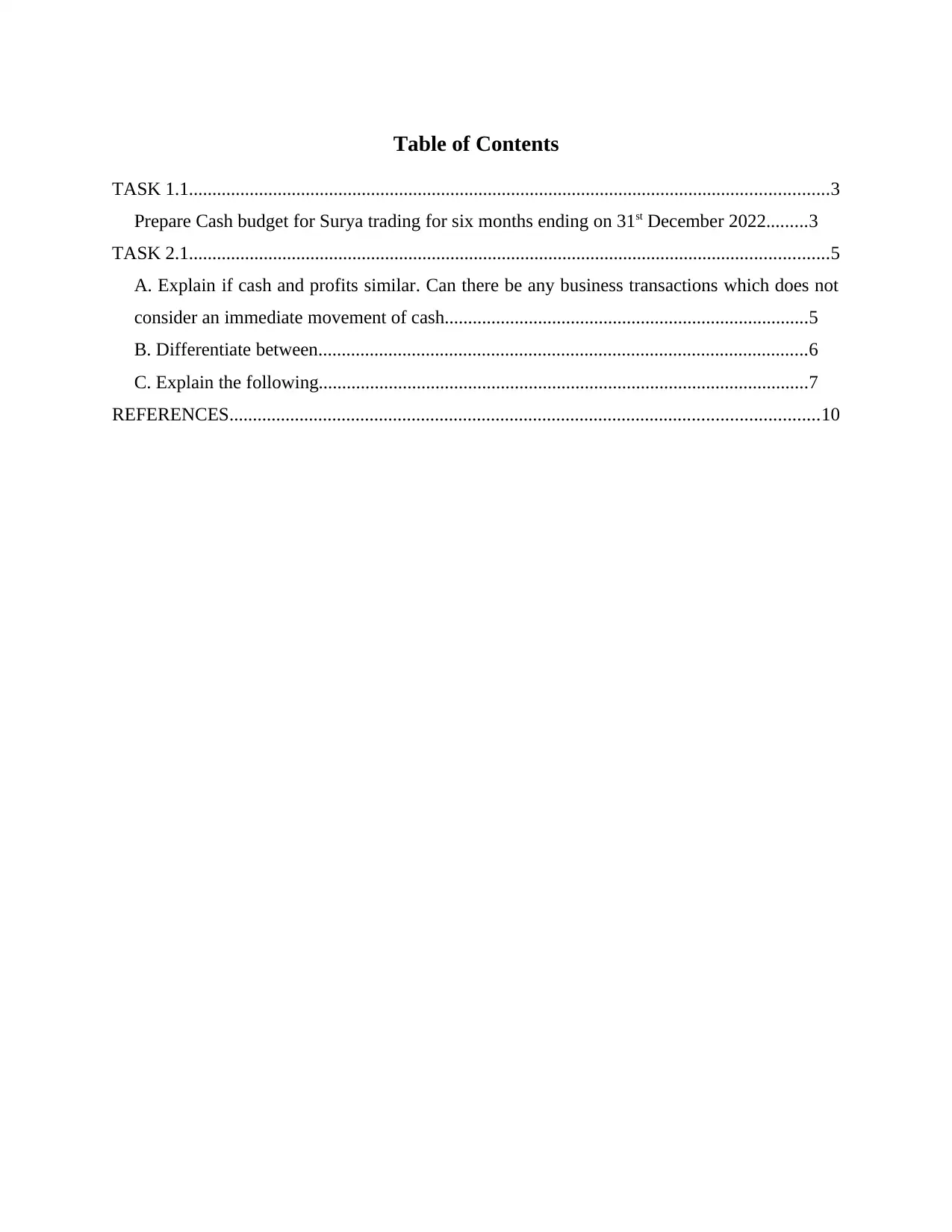
Table of Contents
TASK 1.1.........................................................................................................................................3
Prepare Cash budget for Surya trading for six months ending on 31st December 2022.........3
TASK 2.1.........................................................................................................................................5
A. Explain if cash and profits similar. Can there be any business transactions which does not
consider an immediate movement of cash..............................................................................5
B. Differentiate between.........................................................................................................6
C. Explain the following.........................................................................................................7
REFERENCES..............................................................................................................................10
TASK 1.1.........................................................................................................................................3
Prepare Cash budget for Surya trading for six months ending on 31st December 2022.........3
TASK 2.1.........................................................................................................................................5
A. Explain if cash and profits similar. Can there be any business transactions which does not
consider an immediate movement of cash..............................................................................5
B. Differentiate between.........................................................................................................6
C. Explain the following.........................................................................................................7
REFERENCES..............................................................................................................................10
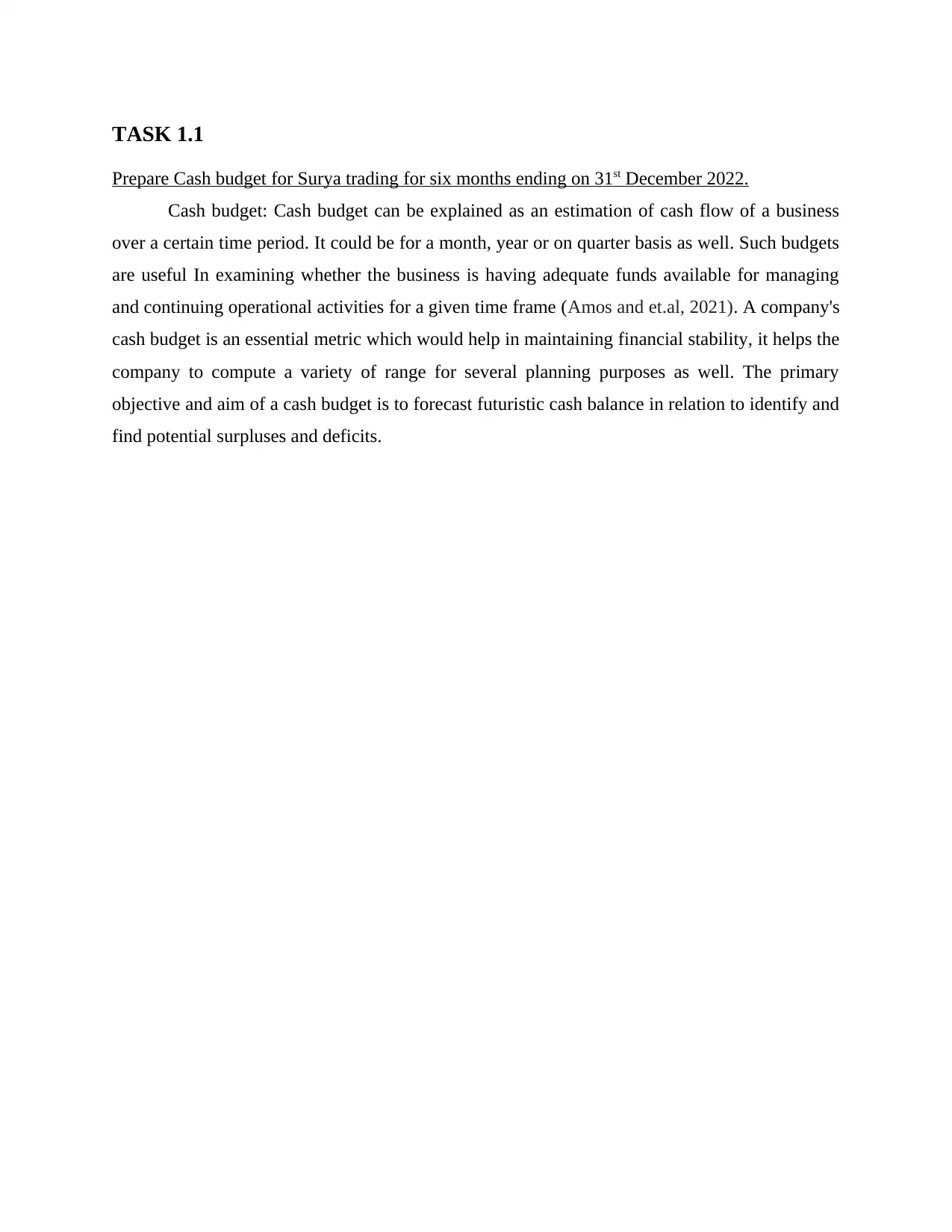
TASK 1.1
Prepare Cash budget for Surya trading for six months ending on 31st December 2022.
Cash budget: Cash budget can be explained as an estimation of cash flow of a business
over a certain time period. It could be for a month, year or on quarter basis as well. Such budgets
are useful In examining whether the business is having adequate funds available for managing
and continuing operational activities for a given time frame (Amos and et.al, 2021). A company's
cash budget is an essential metric which would help in maintaining financial stability, it helps the
company to compute a variety of range for several planning purposes as well. The primary
objective and aim of a cash budget is to forecast futuristic cash balance in relation to identify and
find potential surpluses and deficits.
Prepare Cash budget for Surya trading for six months ending on 31st December 2022.
Cash budget: Cash budget can be explained as an estimation of cash flow of a business
over a certain time period. It could be for a month, year or on quarter basis as well. Such budgets
are useful In examining whether the business is having adequate funds available for managing
and continuing operational activities for a given time frame (Amos and et.al, 2021). A company's
cash budget is an essential metric which would help in maintaining financial stability, it helps the
company to compute a variety of range for several planning purposes as well. The primary
objective and aim of a cash budget is to forecast futuristic cash balance in relation to identify and
find potential surpluses and deficits.
⊘ This is a preview!⊘
Do you want full access?
Subscribe today to unlock all pages.

Trusted by 1+ million students worldwide
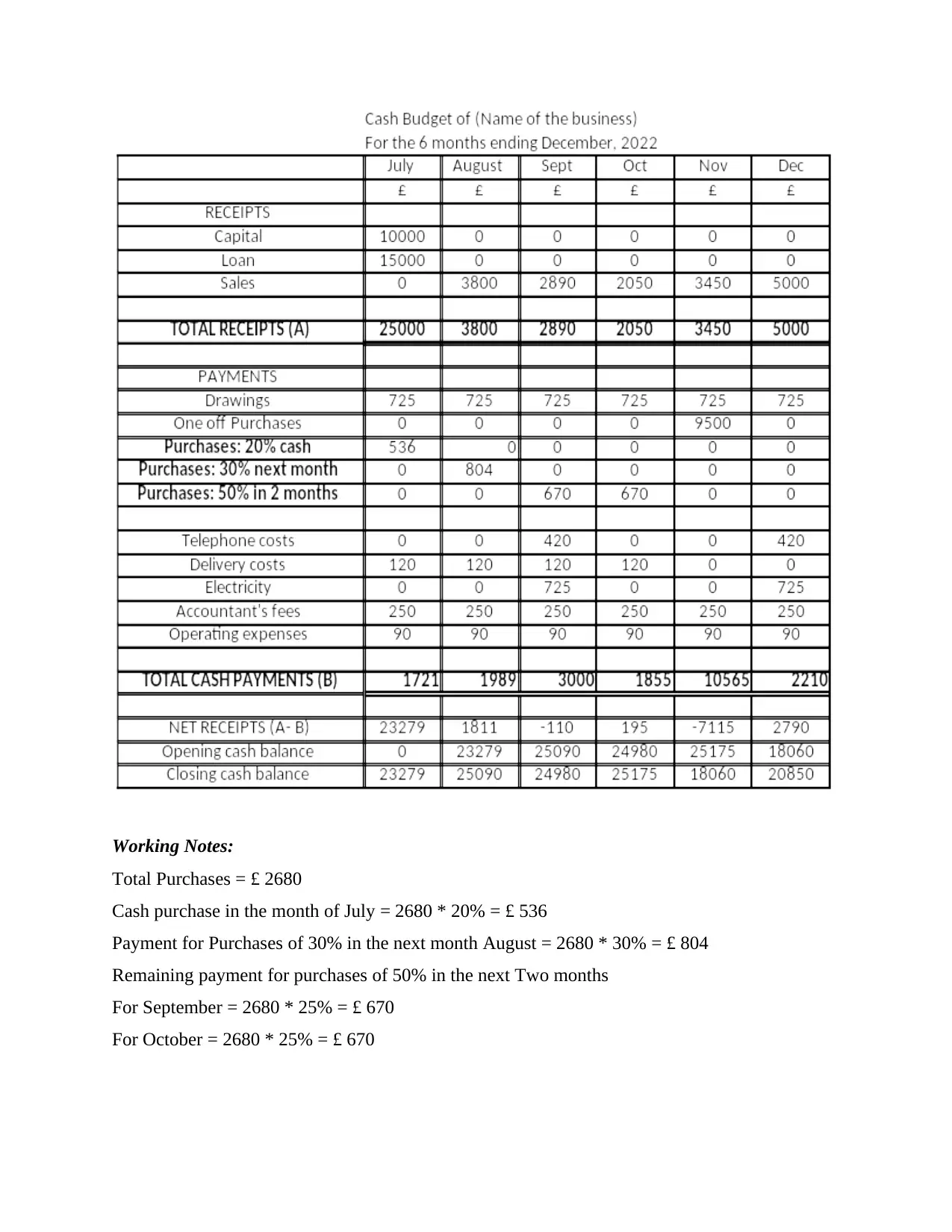
Working Notes:
Total Purchases = £ 2680
Cash purchase in the month of July = 2680 * 20% = £ 536
Payment for Purchases of 30% in the next month August = 2680 * 30% = £ 804
Remaining payment for purchases of 50% in the next Two months
For September = 2680 * 25% = £ 670
For October = 2680 * 25% = £ 670
Total Purchases = £ 2680
Cash purchase in the month of July = 2680 * 20% = £ 536
Payment for Purchases of 30% in the next month August = 2680 * 30% = £ 804
Remaining payment for purchases of 50% in the next Two months
For September = 2680 * 25% = £ 670
For October = 2680 * 25% = £ 670
Paraphrase This Document
Need a fresh take? Get an instant paraphrase of this document with our AI Paraphraser
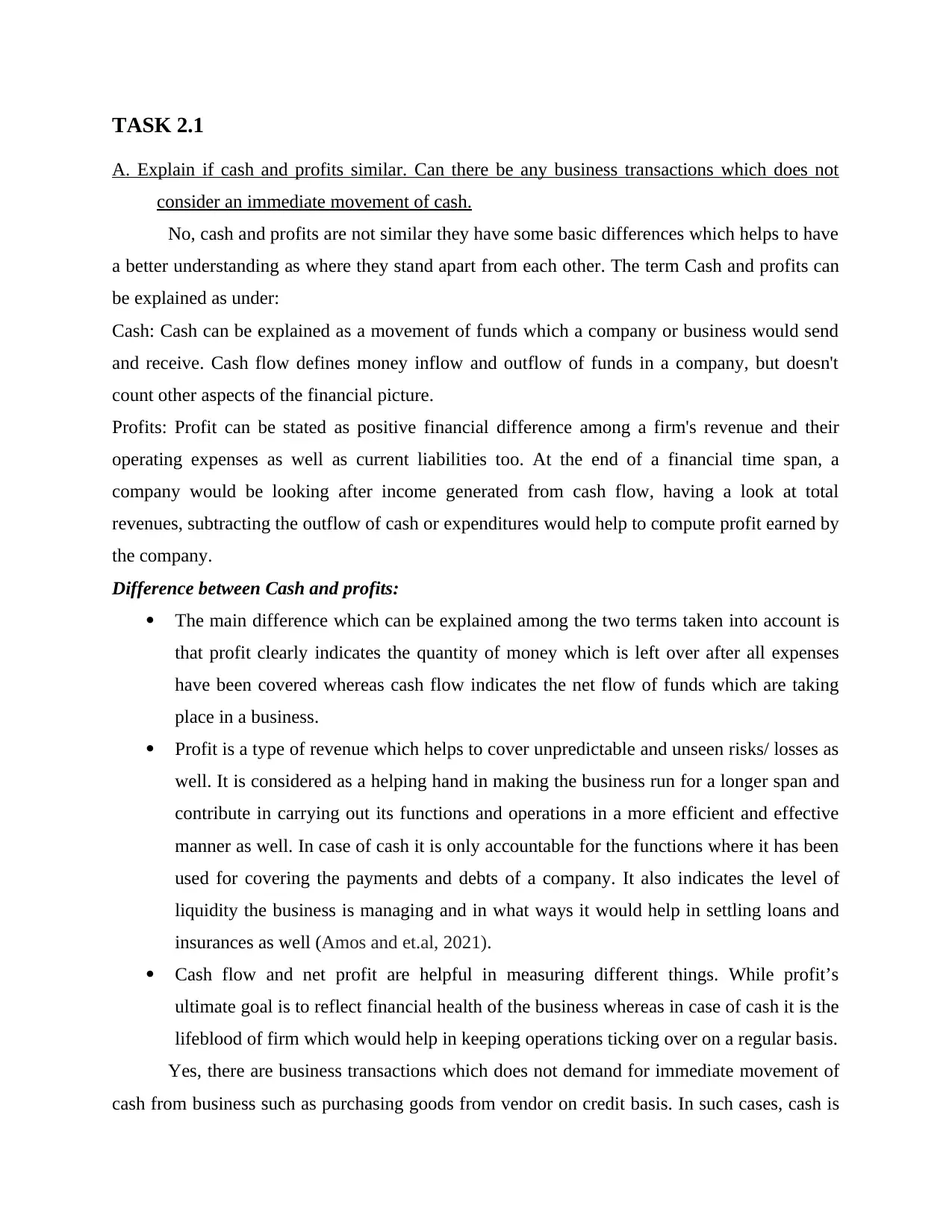
TASK 2.1
A. Explain if cash and profits similar. Can there be any business transactions which does not
consider an immediate movement of cash.
No, cash and profits are not similar they have some basic differences which helps to have
a better understanding as where they stand apart from each other. The term Cash and profits can
be explained as under:
Cash: Cash can be explained as a movement of funds which a company or business would send
and receive. Cash flow defines money inflow and outflow of funds in a company, but doesn't
count other aspects of the financial picture.
Profits: Profit can be stated as positive financial difference among a firm's revenue and their
operating expenses as well as current liabilities too. At the end of a financial time span, a
company would be looking after income generated from cash flow, having a look at total
revenues, subtracting the outflow of cash or expenditures would help to compute profit earned by
the company.
Difference between Cash and profits:
The main difference which can be explained among the two terms taken into account is
that profit clearly indicates the quantity of money which is left over after all expenses
have been covered whereas cash flow indicates the net flow of funds which are taking
place in a business.
Profit is a type of revenue which helps to cover unpredictable and unseen risks/ losses as
well. It is considered as a helping hand in making the business run for a longer span and
contribute in carrying out its functions and operations in a more efficient and effective
manner as well. In case of cash it is only accountable for the functions where it has been
used for covering the payments and debts of a company. It also indicates the level of
liquidity the business is managing and in what ways it would help in settling loans and
insurances as well (Amos and et.al, 2021).
Cash flow and net profit are helpful in measuring different things. While profit’s
ultimate goal is to reflect financial health of the business whereas in case of cash it is the
lifeblood of firm which would help in keeping operations ticking over on a regular basis.
Yes, there are business transactions which does not demand for immediate movement of
cash from business such as purchasing goods from vendor on credit basis. In such cases, cash is
A. Explain if cash and profits similar. Can there be any business transactions which does not
consider an immediate movement of cash.
No, cash and profits are not similar they have some basic differences which helps to have
a better understanding as where they stand apart from each other. The term Cash and profits can
be explained as under:
Cash: Cash can be explained as a movement of funds which a company or business would send
and receive. Cash flow defines money inflow and outflow of funds in a company, but doesn't
count other aspects of the financial picture.
Profits: Profit can be stated as positive financial difference among a firm's revenue and their
operating expenses as well as current liabilities too. At the end of a financial time span, a
company would be looking after income generated from cash flow, having a look at total
revenues, subtracting the outflow of cash or expenditures would help to compute profit earned by
the company.
Difference between Cash and profits:
The main difference which can be explained among the two terms taken into account is
that profit clearly indicates the quantity of money which is left over after all expenses
have been covered whereas cash flow indicates the net flow of funds which are taking
place in a business.
Profit is a type of revenue which helps to cover unpredictable and unseen risks/ losses as
well. It is considered as a helping hand in making the business run for a longer span and
contribute in carrying out its functions and operations in a more efficient and effective
manner as well. In case of cash it is only accountable for the functions where it has been
used for covering the payments and debts of a company. It also indicates the level of
liquidity the business is managing and in what ways it would help in settling loans and
insurances as well (Amos and et.al, 2021).
Cash flow and net profit are helpful in measuring different things. While profit’s
ultimate goal is to reflect financial health of the business whereas in case of cash it is the
lifeblood of firm which would help in keeping operations ticking over on a regular basis.
Yes, there are business transactions which does not demand for immediate movement of
cash from business such as purchasing goods from vendor on credit basis. In such cases, cash is
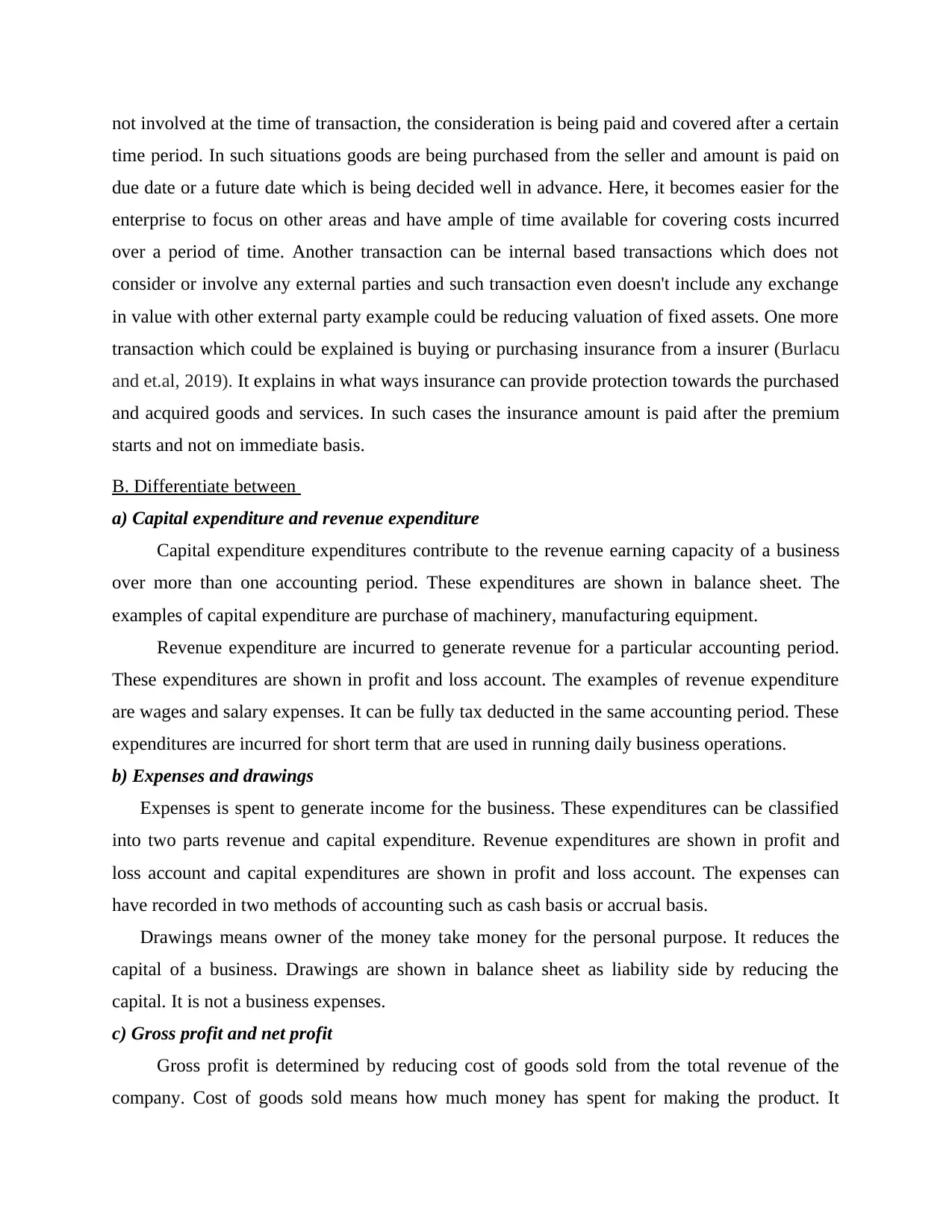
not involved at the time of transaction, the consideration is being paid and covered after a certain
time period. In such situations goods are being purchased from the seller and amount is paid on
due date or a future date which is being decided well in advance. Here, it becomes easier for the
enterprise to focus on other areas and have ample of time available for covering costs incurred
over a period of time. Another transaction can be internal based transactions which does not
consider or involve any external parties and such transaction even doesn't include any exchange
in value with other external party example could be reducing valuation of fixed assets. One more
transaction which could be explained is buying or purchasing insurance from a insurer (Burlacu
and et.al, 2019). It explains in what ways insurance can provide protection towards the purchased
and acquired goods and services. In such cases the insurance amount is paid after the premium
starts and not on immediate basis.
B. Differentiate between
a) Capital expenditure and revenue expenditure
Capital expenditure expenditures contribute to the revenue earning capacity of a business
over more than one accounting period. These expenditures are shown in balance sheet. The
examples of capital expenditure are purchase of machinery, manufacturing equipment.
Revenue expenditure are incurred to generate revenue for a particular accounting period.
These expenditures are shown in profit and loss account. The examples of revenue expenditure
are wages and salary expenses. It can be fully tax deducted in the same accounting period. These
expenditures are incurred for short term that are used in running daily business operations.
b) Expenses and drawings
Expenses is spent to generate income for the business. These expenditures can be classified
into two parts revenue and capital expenditure. Revenue expenditures are shown in profit and
loss account and capital expenditures are shown in profit and loss account. The expenses can
have recorded in two methods of accounting such as cash basis or accrual basis.
Drawings means owner of the money take money for the personal purpose. It reduces the
capital of a business. Drawings are shown in balance sheet as liability side by reducing the
capital. It is not a business expenses.
c) Gross profit and net profit
Gross profit is determined by reducing cost of goods sold from the total revenue of the
company. Cost of goods sold means how much money has spent for making the product. It
time period. In such situations goods are being purchased from the seller and amount is paid on
due date or a future date which is being decided well in advance. Here, it becomes easier for the
enterprise to focus on other areas and have ample of time available for covering costs incurred
over a period of time. Another transaction can be internal based transactions which does not
consider or involve any external parties and such transaction even doesn't include any exchange
in value with other external party example could be reducing valuation of fixed assets. One more
transaction which could be explained is buying or purchasing insurance from a insurer (Burlacu
and et.al, 2019). It explains in what ways insurance can provide protection towards the purchased
and acquired goods and services. In such cases the insurance amount is paid after the premium
starts and not on immediate basis.
B. Differentiate between
a) Capital expenditure and revenue expenditure
Capital expenditure expenditures contribute to the revenue earning capacity of a business
over more than one accounting period. These expenditures are shown in balance sheet. The
examples of capital expenditure are purchase of machinery, manufacturing equipment.
Revenue expenditure are incurred to generate revenue for a particular accounting period.
These expenditures are shown in profit and loss account. The examples of revenue expenditure
are wages and salary expenses. It can be fully tax deducted in the same accounting period. These
expenditures are incurred for short term that are used in running daily business operations.
b) Expenses and drawings
Expenses is spent to generate income for the business. These expenditures can be classified
into two parts revenue and capital expenditure. Revenue expenditures are shown in profit and
loss account and capital expenditures are shown in profit and loss account. The expenses can
have recorded in two methods of accounting such as cash basis or accrual basis.
Drawings means owner of the money take money for the personal purpose. It reduces the
capital of a business. Drawings are shown in balance sheet as liability side by reducing the
capital. It is not a business expenses.
c) Gross profit and net profit
Gross profit is determined by reducing cost of goods sold from the total revenue of the
company. Cost of goods sold means how much money has spent for making the product. It
⊘ This is a preview!⊘
Do you want full access?
Subscribe today to unlock all pages.

Trusted by 1+ million students worldwide
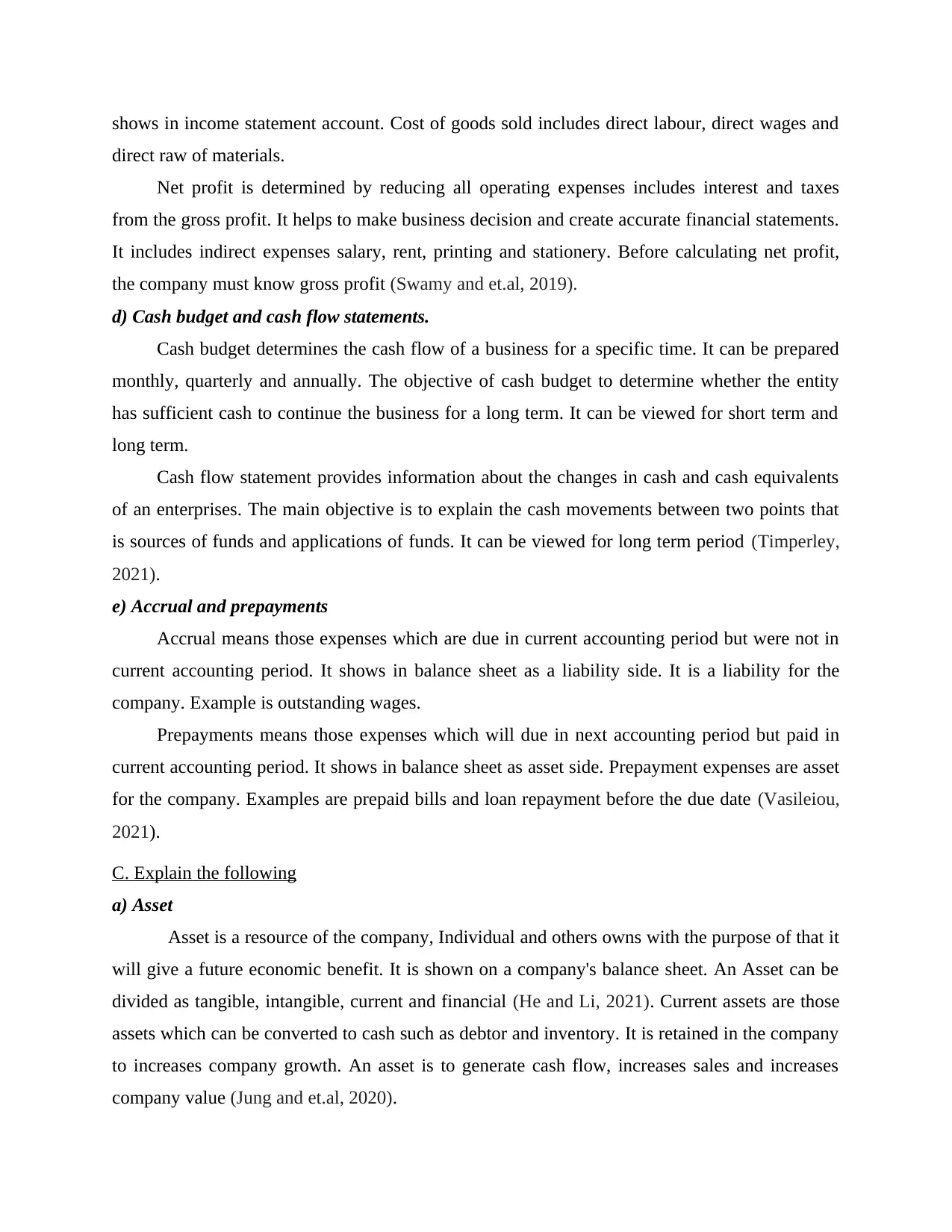
shows in income statement account. Cost of goods sold includes direct labour, direct wages and
direct raw of materials.
Net profit is determined by reducing all operating expenses includes interest and taxes
from the gross profit. It helps to make business decision and create accurate financial statements.
It includes indirect expenses salary, rent, printing and stationery. Before calculating net profit,
the company must know gross profit (Swamy and et.al, 2019).
d) Cash budget and cash flow statements.
Cash budget determines the cash flow of a business for a specific time. It can be prepared
monthly, quarterly and annually. The objective of cash budget to determine whether the entity
has sufficient cash to continue the business for a long term. It can be viewed for short term and
long term.
Cash flow statement provides information about the changes in cash and cash equivalents
of an enterprises. The main objective is to explain the cash movements between two points that
is sources of funds and applications of funds. It can be viewed for long term period (Timperley,
2021).
e) Accrual and prepayments
Accrual means those expenses which are due in current accounting period but were not in
current accounting period. It shows in balance sheet as a liability side. It is a liability for the
company. Example is outstanding wages.
Prepayments means those expenses which will due in next accounting period but paid in
current accounting period. It shows in balance sheet as asset side. Prepayment expenses are asset
for the company. Examples are prepaid bills and loan repayment before the due date (Vasileiou,
2021).
C. Explain the following
a) Asset
Asset is a resource of the company, Individual and others owns with the purpose of that it
will give a future economic benefit. It is shown on a company's balance sheet. An Asset can be
divided as tangible, intangible, current and financial (He and Li, 2021). Current assets are those
assets which can be converted to cash such as debtor and inventory. It is retained in the company
to increases company growth. An asset is to generate cash flow, increases sales and increases
company value (Jung and et.al, 2020).
direct raw of materials.
Net profit is determined by reducing all operating expenses includes interest and taxes
from the gross profit. It helps to make business decision and create accurate financial statements.
It includes indirect expenses salary, rent, printing and stationery. Before calculating net profit,
the company must know gross profit (Swamy and et.al, 2019).
d) Cash budget and cash flow statements.
Cash budget determines the cash flow of a business for a specific time. It can be prepared
monthly, quarterly and annually. The objective of cash budget to determine whether the entity
has sufficient cash to continue the business for a long term. It can be viewed for short term and
long term.
Cash flow statement provides information about the changes in cash and cash equivalents
of an enterprises. The main objective is to explain the cash movements between two points that
is sources of funds and applications of funds. It can be viewed for long term period (Timperley,
2021).
e) Accrual and prepayments
Accrual means those expenses which are due in current accounting period but were not in
current accounting period. It shows in balance sheet as a liability side. It is a liability for the
company. Example is outstanding wages.
Prepayments means those expenses which will due in next accounting period but paid in
current accounting period. It shows in balance sheet as asset side. Prepayment expenses are asset
for the company. Examples are prepaid bills and loan repayment before the due date (Vasileiou,
2021).
C. Explain the following
a) Asset
Asset is a resource of the company, Individual and others owns with the purpose of that it
will give a future economic benefit. It is shown on a company's balance sheet. An Asset can be
divided as tangible, intangible, current and financial (He and Li, 2021). Current assets are those
assets which can be converted to cash such as debtor and inventory. It is retained in the company
to increases company growth. An asset is to generate cash flow, increases sales and increases
company value (Jung and et.al, 2020).
Paraphrase This Document
Need a fresh take? Get an instant paraphrase of this document with our AI Paraphraser
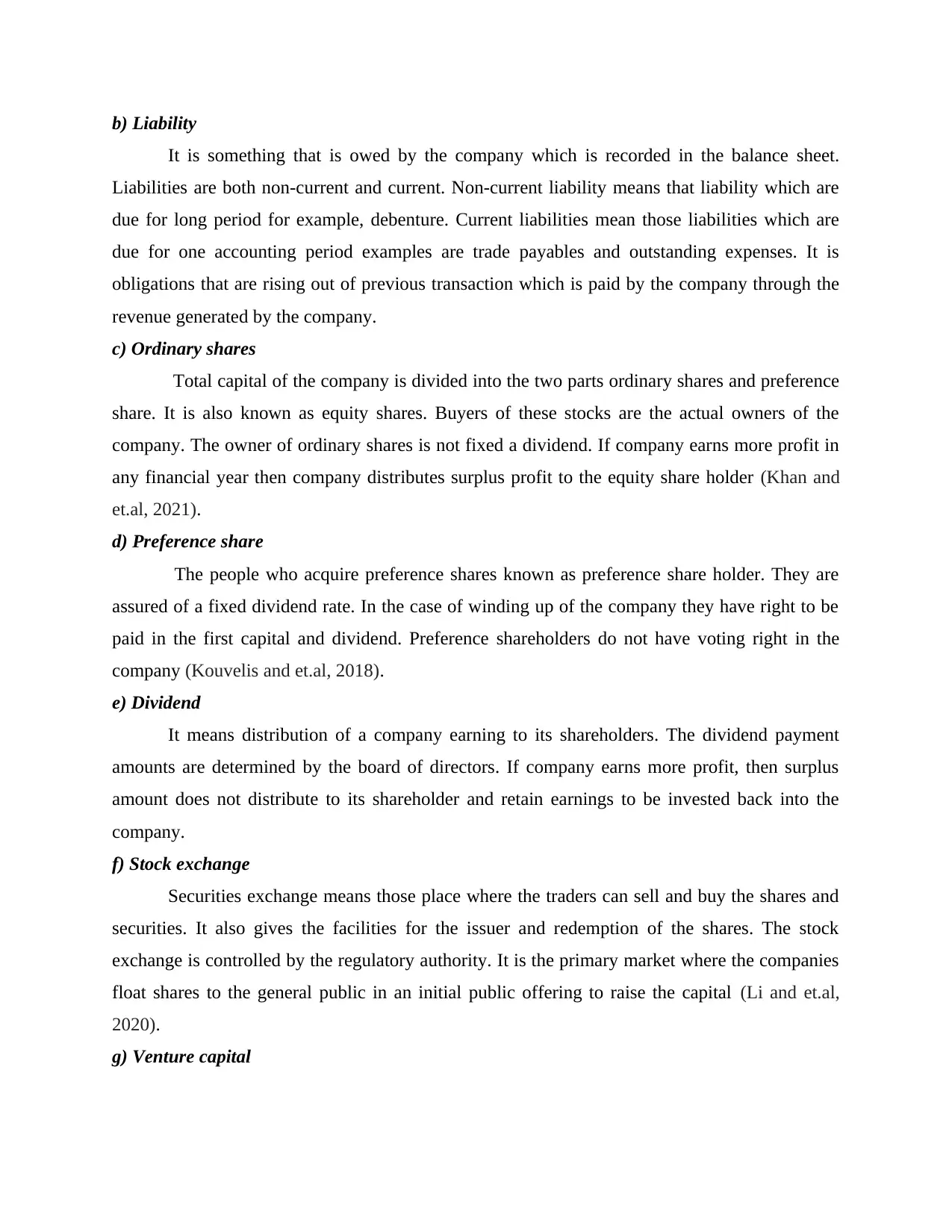
b) Liability
It is something that is owed by the company which is recorded in the balance sheet.
Liabilities are both non-current and current. Non-current liability means that liability which are
due for long period for example, debenture. Current liabilities mean those liabilities which are
due for one accounting period examples are trade payables and outstanding expenses. It is
obligations that are rising out of previous transaction which is paid by the company through the
revenue generated by the company.
c) Ordinary shares
Total capital of the company is divided into the two parts ordinary shares and preference
share. It is also known as equity shares. Buyers of these stocks are the actual owners of the
company. The owner of ordinary shares is not fixed a dividend. If company earns more profit in
any financial year then company distributes surplus profit to the equity share holder (Khan and
et.al, 2021).
d) Preference share
The people who acquire preference shares known as preference share holder. They are
assured of a fixed dividend rate. In the case of winding up of the company they have right to be
paid in the first capital and dividend. Preference shareholders do not have voting right in the
company (Kouvelis and et.al, 2018).
e) Dividend
It means distribution of a company earning to its shareholders. The dividend payment
amounts are determined by the board of directors. If company earns more profit, then surplus
amount does not distribute to its shareholder and retain earnings to be invested back into the
company.
f) Stock exchange
Securities exchange means those place where the traders can sell and buy the shares and
securities. It also gives the facilities for the issuer and redemption of the shares. The stock
exchange is controlled by the regulatory authority. It is the primary market where the companies
float shares to the general public in an initial public offering to raise the capital (Li and et.al,
2020).
g) Venture capital
It is something that is owed by the company which is recorded in the balance sheet.
Liabilities are both non-current and current. Non-current liability means that liability which are
due for long period for example, debenture. Current liabilities mean those liabilities which are
due for one accounting period examples are trade payables and outstanding expenses. It is
obligations that are rising out of previous transaction which is paid by the company through the
revenue generated by the company.
c) Ordinary shares
Total capital of the company is divided into the two parts ordinary shares and preference
share. It is also known as equity shares. Buyers of these stocks are the actual owners of the
company. The owner of ordinary shares is not fixed a dividend. If company earns more profit in
any financial year then company distributes surplus profit to the equity share holder (Khan and
et.al, 2021).
d) Preference share
The people who acquire preference shares known as preference share holder. They are
assured of a fixed dividend rate. In the case of winding up of the company they have right to be
paid in the first capital and dividend. Preference shareholders do not have voting right in the
company (Kouvelis and et.al, 2018).
e) Dividend
It means distribution of a company earning to its shareholders. The dividend payment
amounts are determined by the board of directors. If company earns more profit, then surplus
amount does not distribute to its shareholder and retain earnings to be invested back into the
company.
f) Stock exchange
Securities exchange means those place where the traders can sell and buy the shares and
securities. It also gives the facilities for the issuer and redemption of the shares. The stock
exchange is controlled by the regulatory authority. It is the primary market where the companies
float shares to the general public in an initial public offering to raise the capital (Li and et.al,
2020).
g) Venture capital
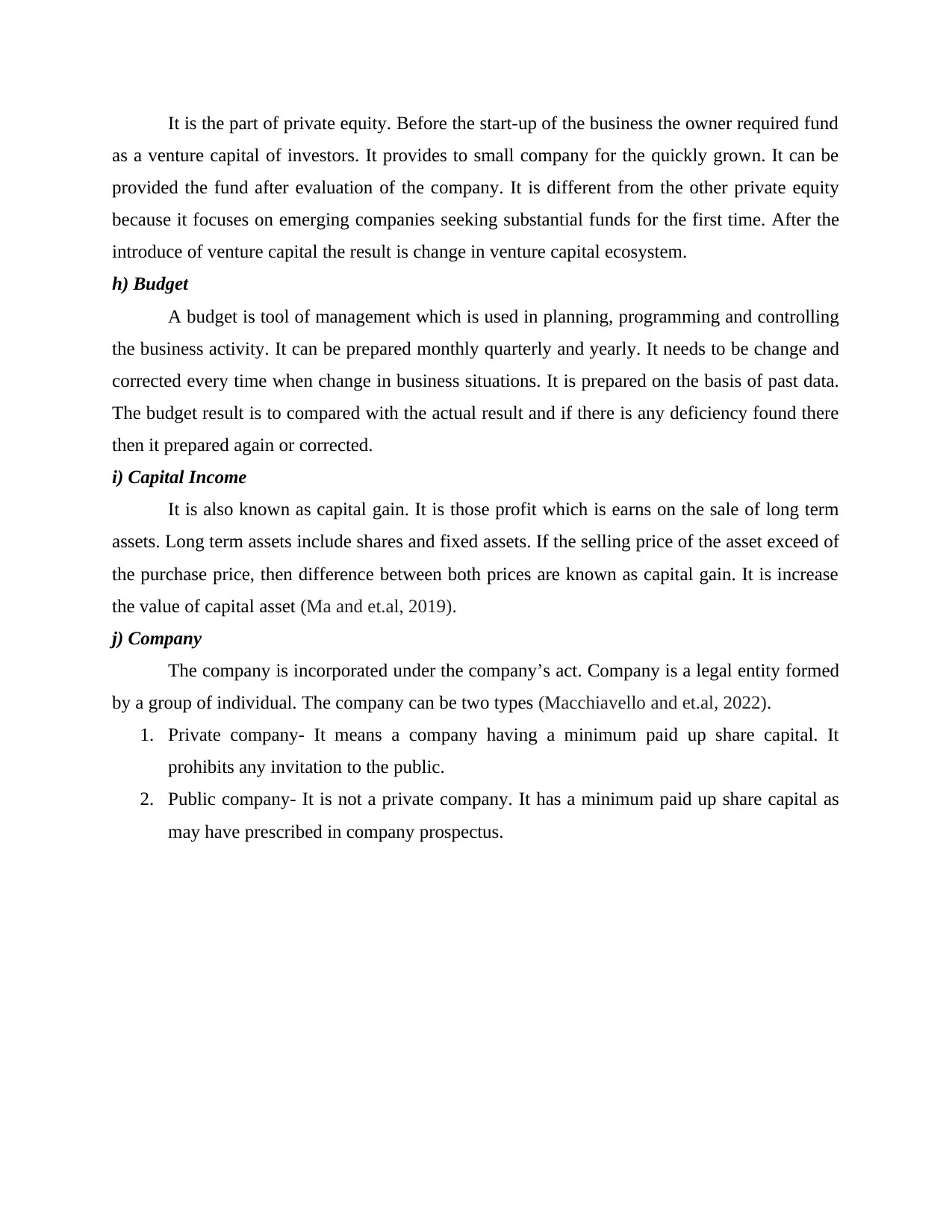
It is the part of private equity. Before the start-up of the business the owner required fund
as a venture capital of investors. It provides to small company for the quickly grown. It can be
provided the fund after evaluation of the company. It is different from the other private equity
because it focuses on emerging companies seeking substantial funds for the first time. After the
introduce of venture capital the result is change in venture capital ecosystem.
h) Budget
A budget is tool of management which is used in planning, programming and controlling
the business activity. It can be prepared monthly quarterly and yearly. It needs to be change and
corrected every time when change in business situations. It is prepared on the basis of past data.
The budget result is to compared with the actual result and if there is any deficiency found there
then it prepared again or corrected.
i) Capital Income
It is also known as capital gain. It is those profit which is earns on the sale of long term
assets. Long term assets include shares and fixed assets. If the selling price of the asset exceed of
the purchase price, then difference between both prices are known as capital gain. It is increase
the value of capital asset (Ma and et.al, 2019).
j) Company
The company is incorporated under the company’s act. Company is a legal entity formed
by a group of individual. The company can be two types (Macchiavello and et.al, 2022).
1. Private company- It means a company having a minimum paid up share capital. It
prohibits any invitation to the public.
2. Public company- It is not a private company. It has a minimum paid up share capital as
may have prescribed in company prospectus.
as a venture capital of investors. It provides to small company for the quickly grown. It can be
provided the fund after evaluation of the company. It is different from the other private equity
because it focuses on emerging companies seeking substantial funds for the first time. After the
introduce of venture capital the result is change in venture capital ecosystem.
h) Budget
A budget is tool of management which is used in planning, programming and controlling
the business activity. It can be prepared monthly quarterly and yearly. It needs to be change and
corrected every time when change in business situations. It is prepared on the basis of past data.
The budget result is to compared with the actual result and if there is any deficiency found there
then it prepared again or corrected.
i) Capital Income
It is also known as capital gain. It is those profit which is earns on the sale of long term
assets. Long term assets include shares and fixed assets. If the selling price of the asset exceed of
the purchase price, then difference between both prices are known as capital gain. It is increase
the value of capital asset (Ma and et.al, 2019).
j) Company
The company is incorporated under the company’s act. Company is a legal entity formed
by a group of individual. The company can be two types (Macchiavello and et.al, 2022).
1. Private company- It means a company having a minimum paid up share capital. It
prohibits any invitation to the public.
2. Public company- It is not a private company. It has a minimum paid up share capital as
may have prescribed in company prospectus.
⊘ This is a preview!⊘
Do you want full access?
Subscribe today to unlock all pages.

Trusted by 1+ million students worldwide
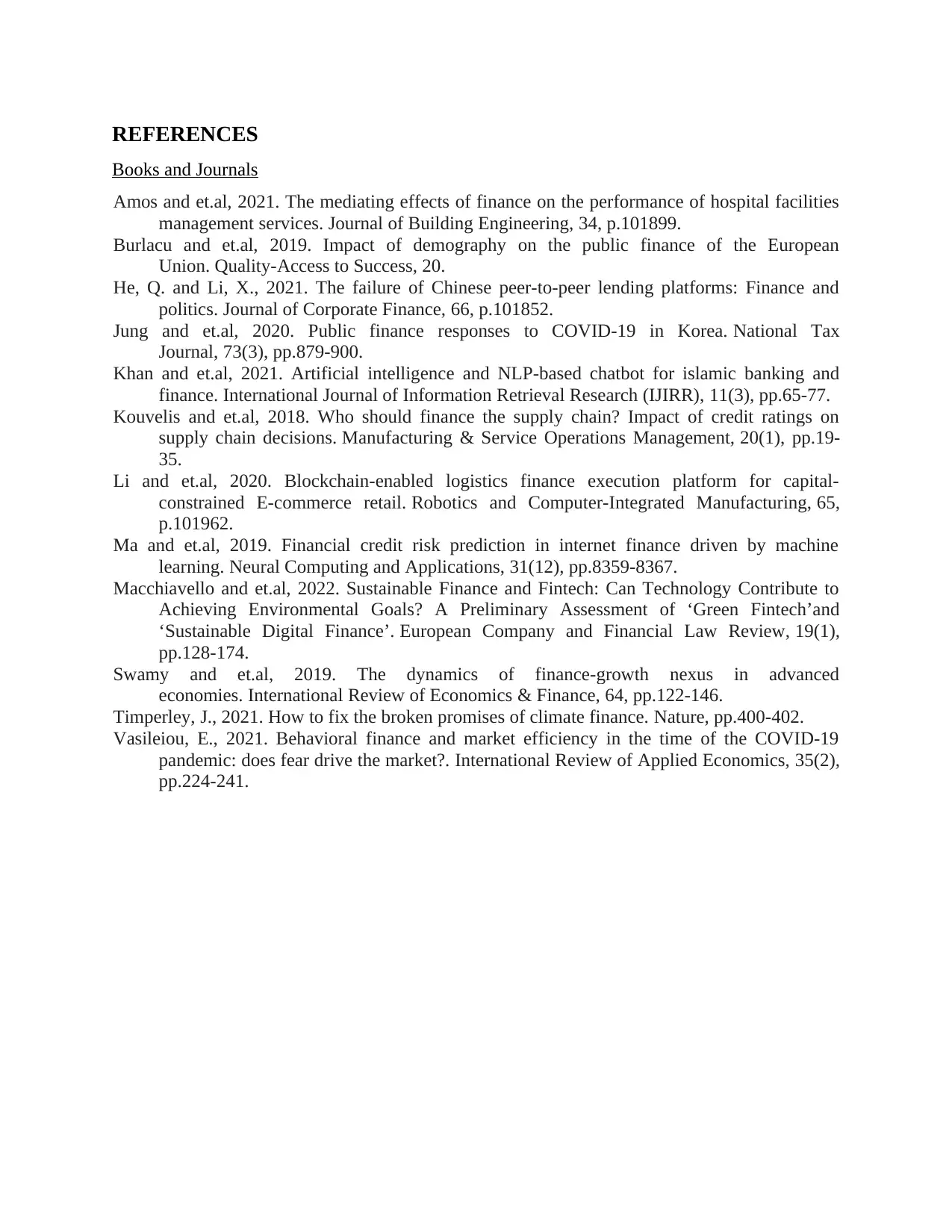
REFERENCES
Books and Journals
Amos and et.al, 2021. The mediating effects of finance on the performance of hospital facilities
management services. Journal of Building Engineering, 34, p.101899.
Burlacu and et.al, 2019. Impact of demography on the public finance of the European
Union. Quality-Access to Success, 20.
He, Q. and Li, X., 2021. The failure of Chinese peer-to-peer lending platforms: Finance and
politics. Journal of Corporate Finance, 66, p.101852.
Jung and et.al, 2020. Public finance responses to COVID-19 in Korea. National Tax
Journal, 73(3), pp.879-900.
Khan and et.al, 2021. Artificial intelligence and NLP-based chatbot for islamic banking and
finance. International Journal of Information Retrieval Research (IJIRR), 11(3), pp.65-77.
Kouvelis and et.al, 2018. Who should finance the supply chain? Impact of credit ratings on
supply chain decisions. Manufacturing & Service Operations Management, 20(1), pp.19-
35.
Li and et.al, 2020. Blockchain-enabled logistics finance execution platform for capital-
constrained E-commerce retail. Robotics and Computer-Integrated Manufacturing, 65,
p.101962.
Ma and et.al, 2019. Financial credit risk prediction in internet finance driven by machine
learning. Neural Computing and Applications, 31(12), pp.8359-8367.
Macchiavello and et.al, 2022. Sustainable Finance and Fintech: Can Technology Contribute to
Achieving Environmental Goals? A Preliminary Assessment of ‘Green Fintech’and
‘Sustainable Digital Finance’. European Company and Financial Law Review, 19(1),
pp.128-174.
Swamy and et.al, 2019. The dynamics of finance-growth nexus in advanced
economies. International Review of Economics & Finance, 64, pp.122-146.
Timperley, J., 2021. How to fix the broken promises of climate finance. Nature, pp.400-402.
Vasileiou, E., 2021. Behavioral finance and market efficiency in the time of the COVID-19
pandemic: does fear drive the market?. International Review of Applied Economics, 35(2),
pp.224-241.
Books and Journals
Amos and et.al, 2021. The mediating effects of finance on the performance of hospital facilities
management services. Journal of Building Engineering, 34, p.101899.
Burlacu and et.al, 2019. Impact of demography on the public finance of the European
Union. Quality-Access to Success, 20.
He, Q. and Li, X., 2021. The failure of Chinese peer-to-peer lending platforms: Finance and
politics. Journal of Corporate Finance, 66, p.101852.
Jung and et.al, 2020. Public finance responses to COVID-19 in Korea. National Tax
Journal, 73(3), pp.879-900.
Khan and et.al, 2021. Artificial intelligence and NLP-based chatbot for islamic banking and
finance. International Journal of Information Retrieval Research (IJIRR), 11(3), pp.65-77.
Kouvelis and et.al, 2018. Who should finance the supply chain? Impact of credit ratings on
supply chain decisions. Manufacturing & Service Operations Management, 20(1), pp.19-
35.
Li and et.al, 2020. Blockchain-enabled logistics finance execution platform for capital-
constrained E-commerce retail. Robotics and Computer-Integrated Manufacturing, 65,
p.101962.
Ma and et.al, 2019. Financial credit risk prediction in internet finance driven by machine
learning. Neural Computing and Applications, 31(12), pp.8359-8367.
Macchiavello and et.al, 2022. Sustainable Finance and Fintech: Can Technology Contribute to
Achieving Environmental Goals? A Preliminary Assessment of ‘Green Fintech’and
‘Sustainable Digital Finance’. European Company and Financial Law Review, 19(1),
pp.128-174.
Swamy and et.al, 2019. The dynamics of finance-growth nexus in advanced
economies. International Review of Economics & Finance, 64, pp.122-146.
Timperley, J., 2021. How to fix the broken promises of climate finance. Nature, pp.400-402.
Vasileiou, E., 2021. Behavioral finance and market efficiency in the time of the COVID-19
pandemic: does fear drive the market?. International Review of Applied Economics, 35(2),
pp.224-241.
1 out of 10
Related Documents
Your All-in-One AI-Powered Toolkit for Academic Success.
+13062052269
info@desklib.com
Available 24*7 on WhatsApp / Email
![[object Object]](/_next/static/media/star-bottom.7253800d.svg)
Unlock your academic potential
Copyright © 2020–2025 A2Z Services. All Rights Reserved. Developed and managed by ZUCOL.





